Object-Oriented Analysis and Design Project: Derby Auctioneers System
VerifiedAdded on 2019/09/22
|9
|1298
|448
Project
AI Summary
This project undertakes a system analysis and design, focusing on the Derby Auctioneers case study, employing an object-oriented approach. It begins with an introduction contrasting structured and object-oriented development methodologies, emphasizing the latter's use of interrelated objects. The project identifies both functional requirements, such as customer login, bidding, and payment processes, and non-functional requirements, including system performance, reliability, and security. A use case model is developed, detailing user interactions like browsing items, bidding, and payment. Detailed use cases are provided for different actors, including system administrators and users. Furthermore, a candidate class list and a class diagram are presented to visualize the system's structure and object interactions. The project concludes by highlighting the successful identification of system requirements and the application of object-oriented principles, reinforcing the understanding of system development approaches.
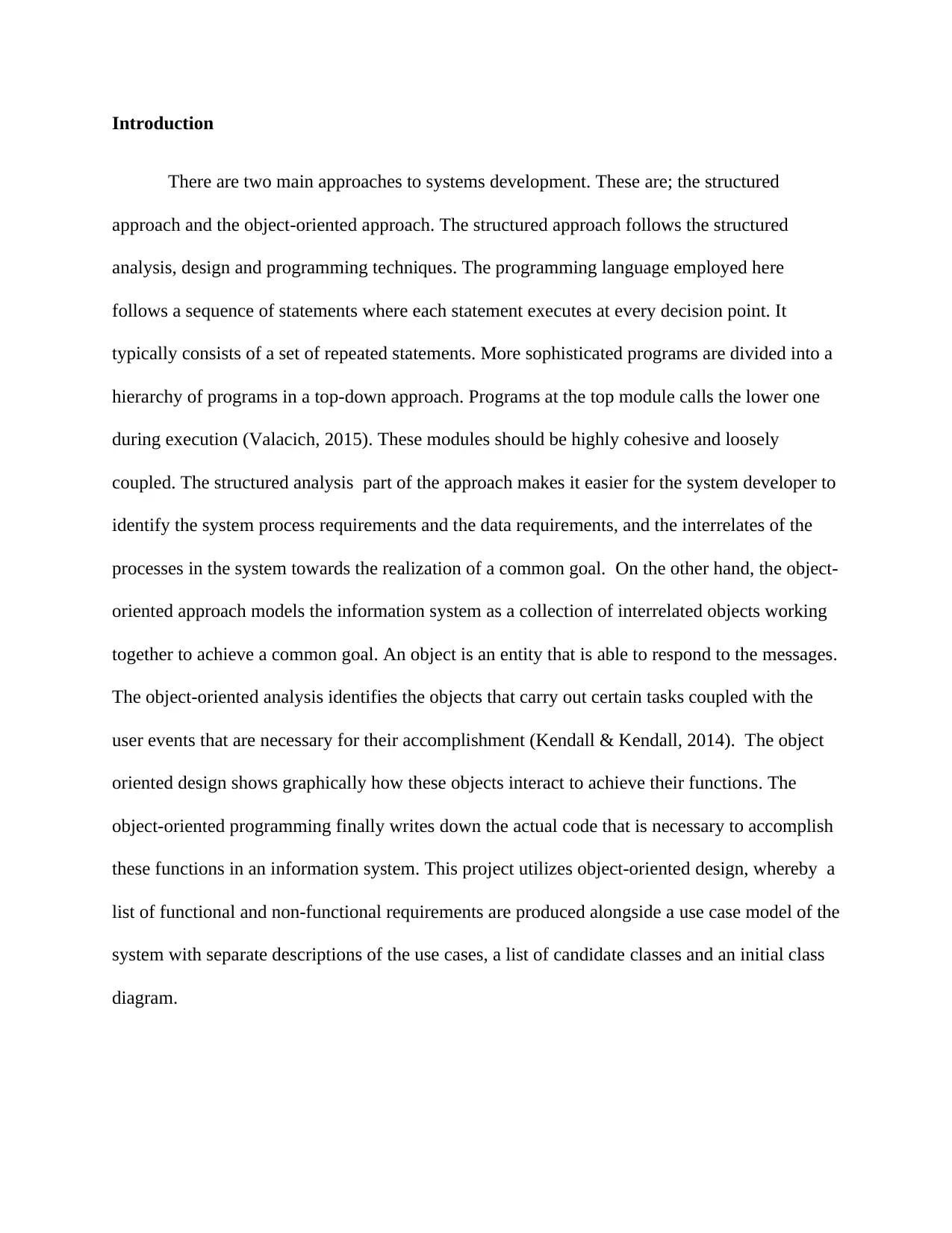
Introduction
There are two main approaches to systems development. These are; the structured
approach and the object-oriented approach. The structured approach follows the structured
analysis, design and programming techniques. The programming language employed here
follows a sequence of statements where each statement executes at every decision point. It
typically consists of a set of repeated statements. More sophisticated programs are divided into a
hierarchy of programs in a top-down approach. Programs at the top module calls the lower one
during execution (Valacich, 2015). These modules should be highly cohesive and loosely
coupled. The structured analysis part of the approach makes it easier for the system developer to
identify the system process requirements and the data requirements, and the interrelates of the
processes in the system towards the realization of a common goal. On the other hand, the object-
oriented approach models the information system as a collection of interrelated objects working
together to achieve a common goal. An object is an entity that is able to respond to the messages.
The object-oriented analysis identifies the objects that carry out certain tasks coupled with the
user events that are necessary for their accomplishment (Kendall & Kendall, 2014). The object
oriented design shows graphically how these objects interact to achieve their functions. The
object-oriented programming finally writes down the actual code that is necessary to accomplish
these functions in an information system. This project utilizes object-oriented design, whereby a
list of functional and non-functional requirements are produced alongside a use case model of the
system with separate descriptions of the use cases, a list of candidate classes and an initial class
diagram.
There are two main approaches to systems development. These are; the structured
approach and the object-oriented approach. The structured approach follows the structured
analysis, design and programming techniques. The programming language employed here
follows a sequence of statements where each statement executes at every decision point. It
typically consists of a set of repeated statements. More sophisticated programs are divided into a
hierarchy of programs in a top-down approach. Programs at the top module calls the lower one
during execution (Valacich, 2015). These modules should be highly cohesive and loosely
coupled. The structured analysis part of the approach makes it easier for the system developer to
identify the system process requirements and the data requirements, and the interrelates of the
processes in the system towards the realization of a common goal. On the other hand, the object-
oriented approach models the information system as a collection of interrelated objects working
together to achieve a common goal. An object is an entity that is able to respond to the messages.
The object-oriented analysis identifies the objects that carry out certain tasks coupled with the
user events that are necessary for their accomplishment (Kendall & Kendall, 2014). The object
oriented design shows graphically how these objects interact to achieve their functions. The
object-oriented programming finally writes down the actual code that is necessary to accomplish
these functions in an information system. This project utilizes object-oriented design, whereby a
list of functional and non-functional requirements are produced alongside a use case model of the
system with separate descriptions of the use cases, a list of candidate classes and an initial class
diagram.
Paraphrase This Document
Need a fresh take? Get an instant paraphrase of this document with our AI Paraphraser
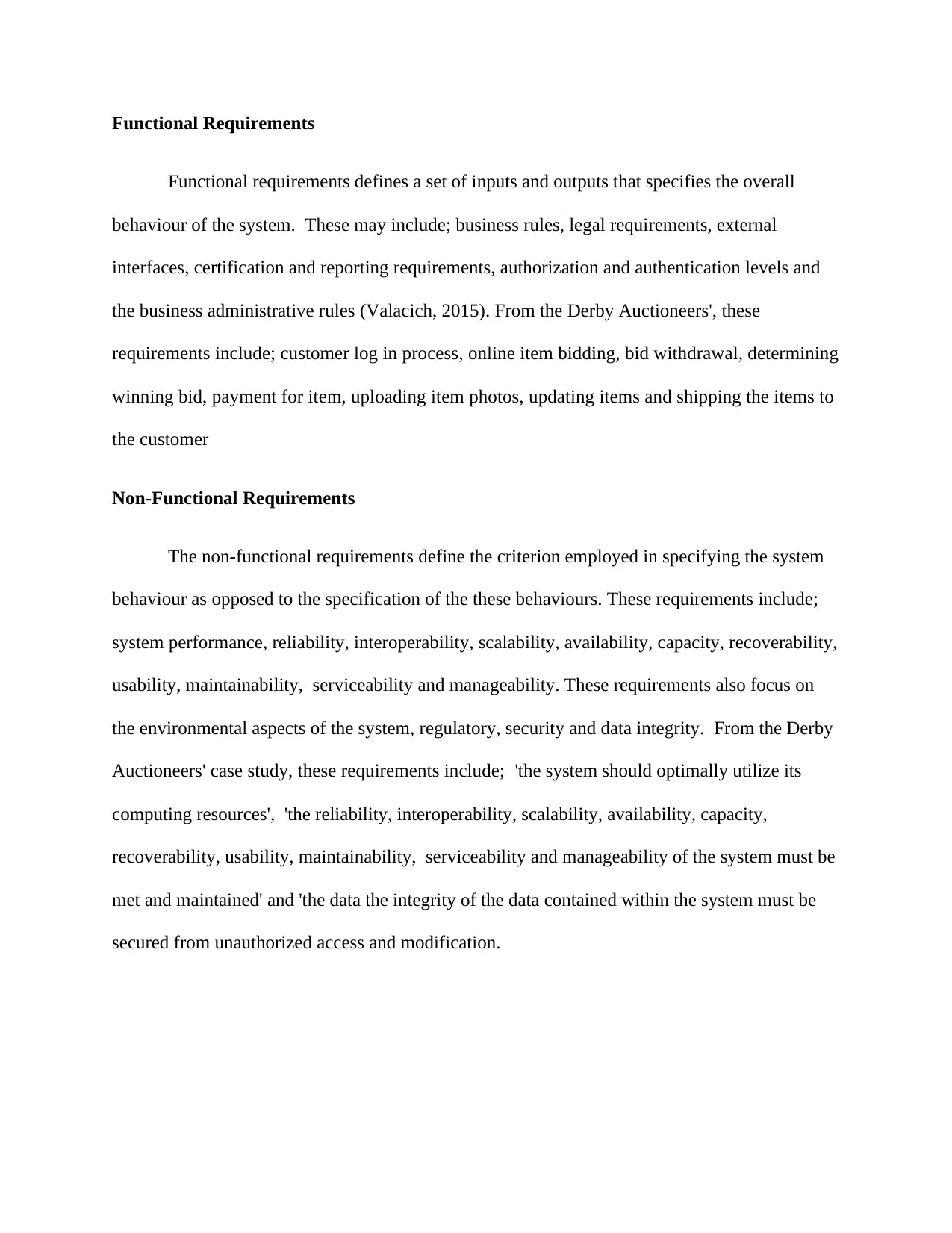
Functional Requirements
Functional requirements defines a set of inputs and outputs that specifies the overall
behaviour of the system. These may include; business rules, legal requirements, external
interfaces, certification and reporting requirements, authorization and authentication levels and
the business administrative rules (Valacich, 2015). From the Derby Auctioneers', these
requirements include; customer log in process, online item bidding, bid withdrawal, determining
winning bid, payment for item, uploading item photos, updating items and shipping the items to
the customer
Non-Functional Requirements
The non-functional requirements define the criterion employed in specifying the system
behaviour as opposed to the specification of the these behaviours. These requirements include;
system performance, reliability, interoperability, scalability, availability, capacity, recoverability,
usability, maintainability, serviceability and manageability. These requirements also focus on
the environmental aspects of the system, regulatory, security and data integrity. From the Derby
Auctioneers' case study, these requirements include; 'the system should optimally utilize its
computing resources', 'the reliability, interoperability, scalability, availability, capacity,
recoverability, usability, maintainability, serviceability and manageability of the system must be
met and maintained' and 'the data the integrity of the data contained within the system must be
secured from unauthorized access and modification.
Functional requirements defines a set of inputs and outputs that specifies the overall
behaviour of the system. These may include; business rules, legal requirements, external
interfaces, certification and reporting requirements, authorization and authentication levels and
the business administrative rules (Valacich, 2015). From the Derby Auctioneers', these
requirements include; customer log in process, online item bidding, bid withdrawal, determining
winning bid, payment for item, uploading item photos, updating items and shipping the items to
the customer
Non-Functional Requirements
The non-functional requirements define the criterion employed in specifying the system
behaviour as opposed to the specification of the these behaviours. These requirements include;
system performance, reliability, interoperability, scalability, availability, capacity, recoverability,
usability, maintainability, serviceability and manageability. These requirements also focus on
the environmental aspects of the system, regulatory, security and data integrity. From the Derby
Auctioneers' case study, these requirements include; 'the system should optimally utilize its
computing resources', 'the reliability, interoperability, scalability, availability, capacity,
recoverability, usability, maintainability, serviceability and manageability of the system must be
met and maintained' and 'the data the integrity of the data contained within the system must be
secured from unauthorized access and modification.
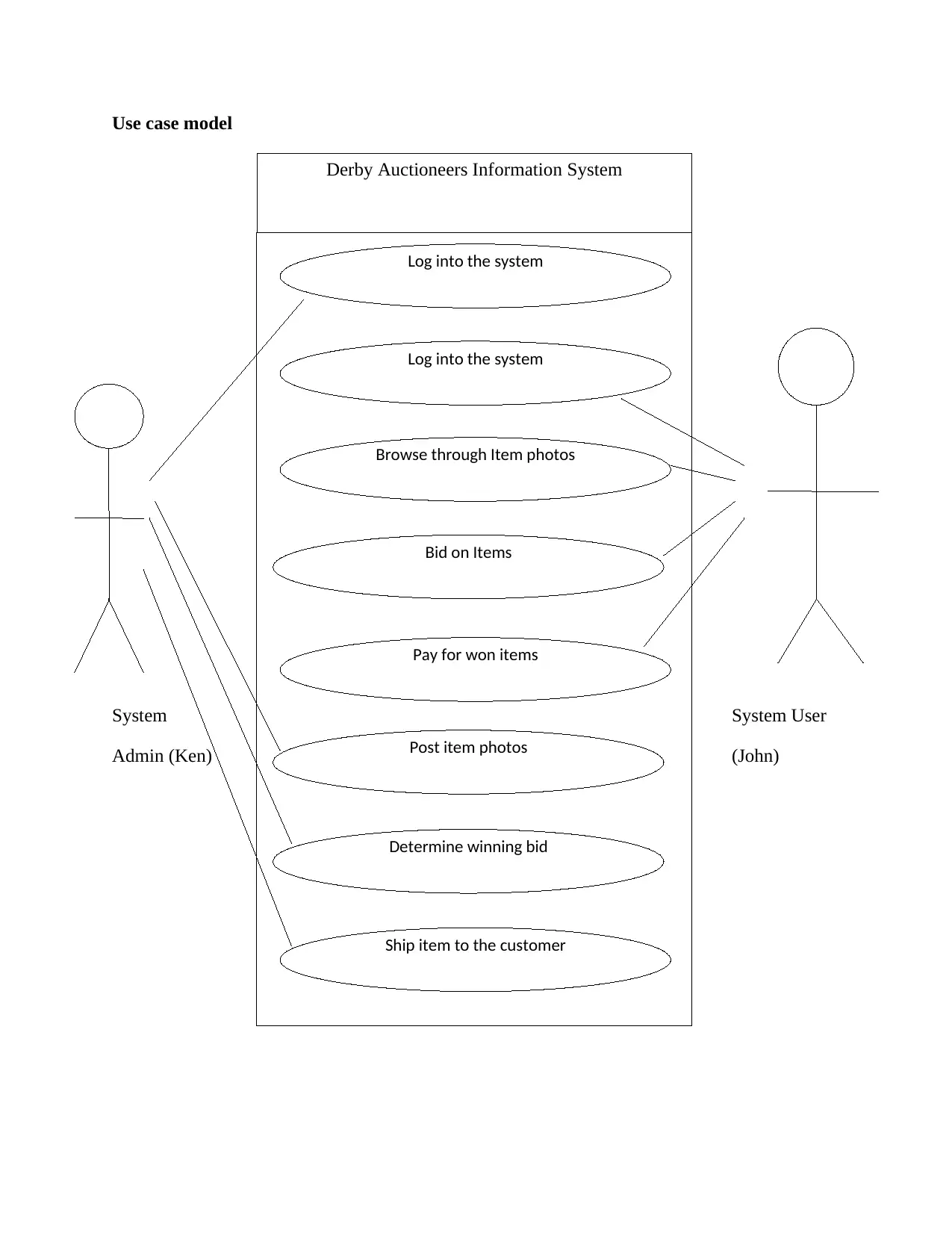
Use case model
System System User
Admin (Ken) (John)
Derby Auctioneers Information System
Log into the system
Log into the system
Browse through Item photos
Bid on Items
Pay for won items
Post item photos
Determine winning bid
Ship item to the customer
System System User
Admin (Ken) (John)
Derby Auctioneers Information System
Log into the system
Log into the system
Browse through Item photos
Bid on Items
Pay for won items
Post item photos
Determine winning bid
Ship item to the customer
⊘ This is a preview!⊘
Do you want full access?
Subscribe today to unlock all pages.

Trusted by 1+ million students worldwide
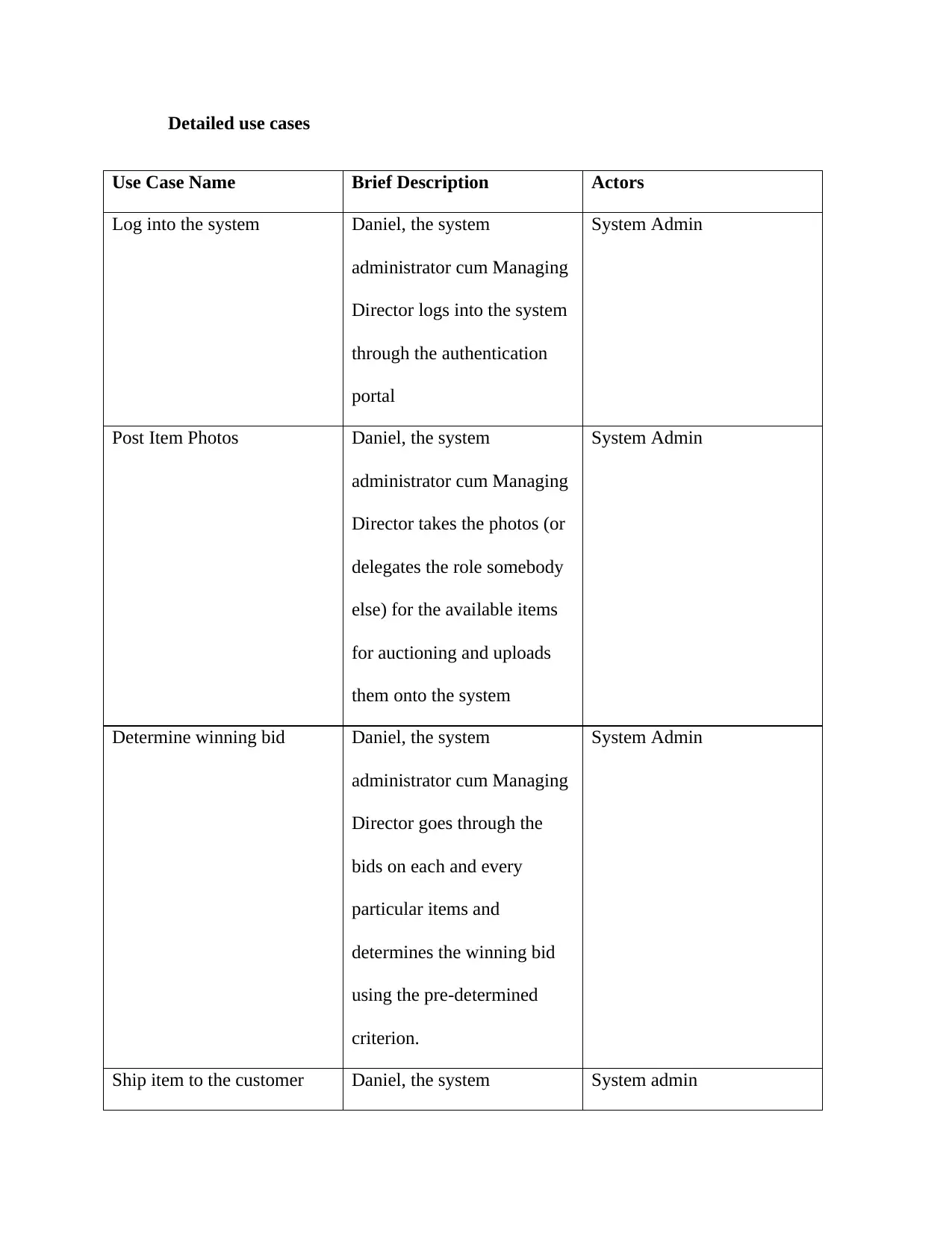
Detailed use cases
Use Case Name Brief Description Actors
Log into the system Daniel, the system
administrator cum Managing
Director logs into the system
through the authentication
portal
System Admin
Post Item Photos Daniel, the system
administrator cum Managing
Director takes the photos (or
delegates the role somebody
else) for the available items
for auctioning and uploads
them onto the system
System Admin
Determine winning bid Daniel, the system
administrator cum Managing
Director goes through the
bids on each and every
particular items and
determines the winning bid
using the pre-determined
criterion.
System Admin
Ship item to the customer Daniel, the system System admin
Use Case Name Brief Description Actors
Log into the system Daniel, the system
administrator cum Managing
Director logs into the system
through the authentication
portal
System Admin
Post Item Photos Daniel, the system
administrator cum Managing
Director takes the photos (or
delegates the role somebody
else) for the available items
for auctioning and uploads
them onto the system
System Admin
Determine winning bid Daniel, the system
administrator cum Managing
Director goes through the
bids on each and every
particular items and
determines the winning bid
using the pre-determined
criterion.
System Admin
Ship item to the customer Daniel, the system System admin
Paraphrase This Document
Need a fresh take? Get an instant paraphrase of this document with our AI Paraphraser
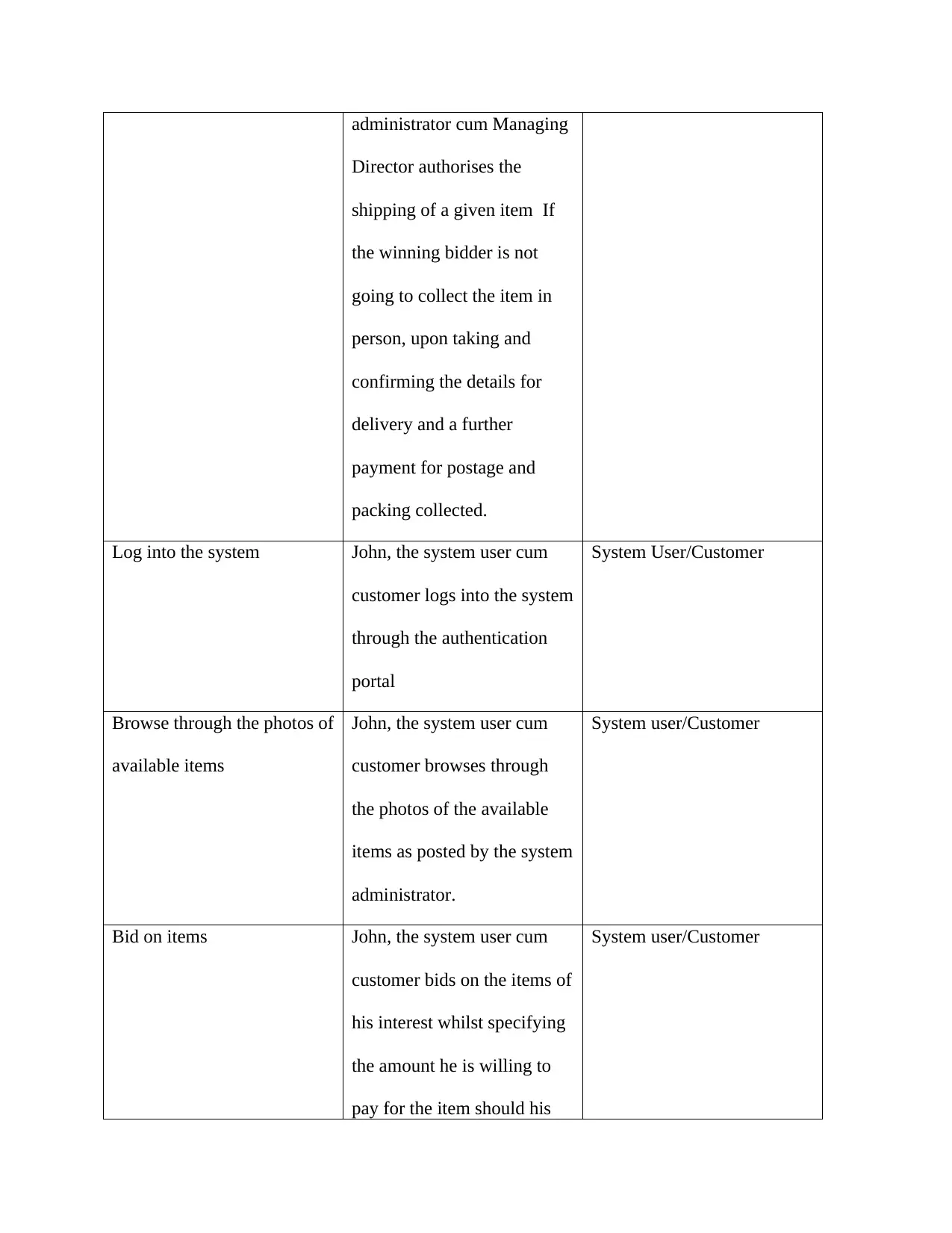
administrator cum Managing
Director authorises the
shipping of a given item If
the winning bidder is not
going to collect the item in
person, upon taking and
confirming the details for
delivery and a further
payment for postage and
packing collected.
Log into the system John, the system user cum
customer logs into the system
through the authentication
portal
System User/Customer
Browse through the photos of
available items
John, the system user cum
customer browses through
the photos of the available
items as posted by the system
administrator.
System user/Customer
Bid on items John, the system user cum
customer bids on the items of
his interest whilst specifying
the amount he is willing to
pay for the item should his
System user/Customer
Director authorises the
shipping of a given item If
the winning bidder is not
going to collect the item in
person, upon taking and
confirming the details for
delivery and a further
payment for postage and
packing collected.
Log into the system John, the system user cum
customer logs into the system
through the authentication
portal
System User/Customer
Browse through the photos of
available items
John, the system user cum
customer browses through
the photos of the available
items as posted by the system
administrator.
System user/Customer
Bid on items John, the system user cum
customer bids on the items of
his interest whilst specifying
the amount he is willing to
pay for the item should his
System user/Customer
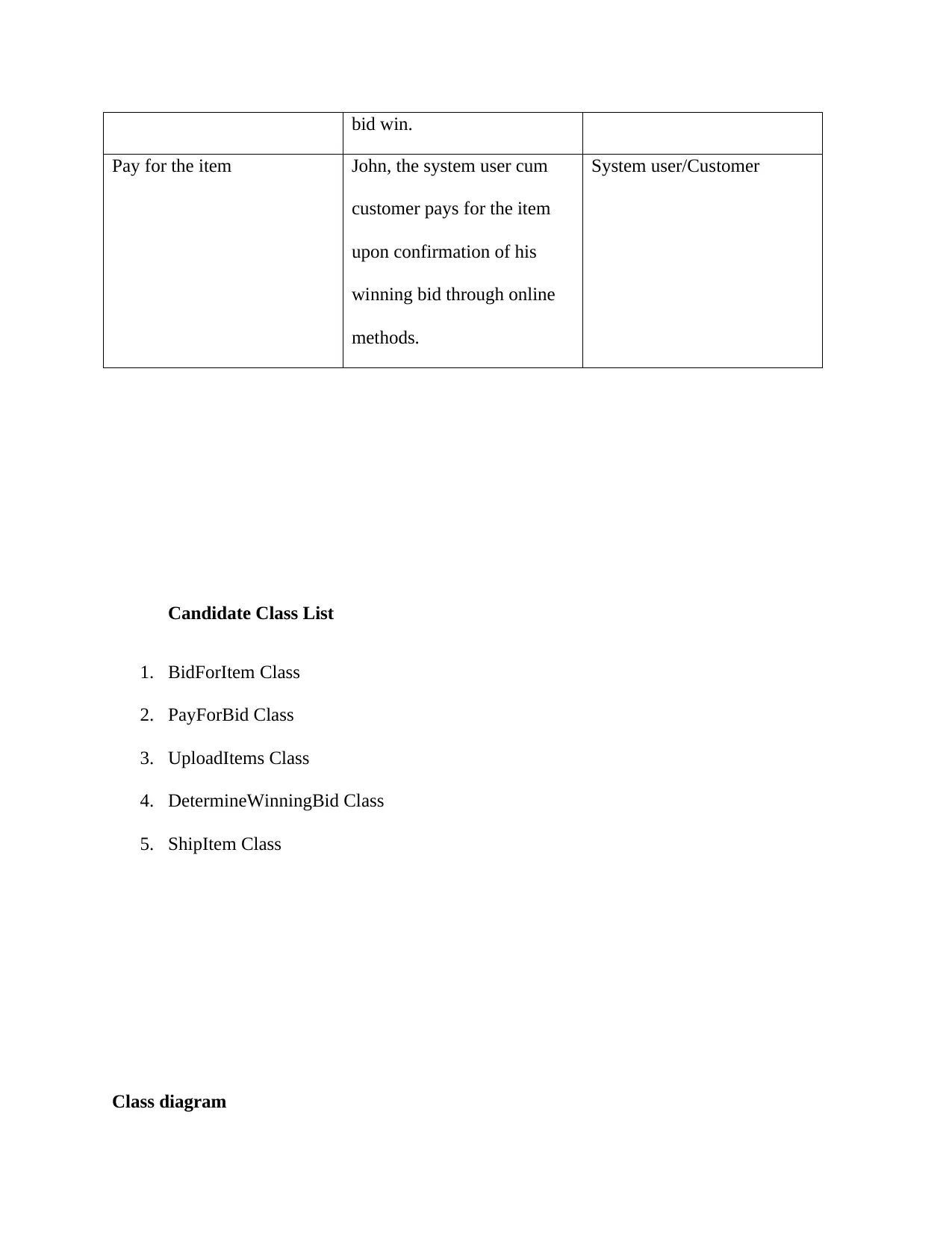
bid win.
Pay for the item John, the system user cum
customer pays for the item
upon confirmation of his
winning bid through online
methods.
System user/Customer
Candidate Class List
1. BidForItem Class
2. PayForBid Class
3. UploadItems Class
4. DetermineWinningBid Class
5. ShipItem Class
Class diagram
Pay for the item John, the system user cum
customer pays for the item
upon confirmation of his
winning bid through online
methods.
System user/Customer
Candidate Class List
1. BidForItem Class
2. PayForBid Class
3. UploadItems Class
4. DetermineWinningBid Class
5. ShipItem Class
Class diagram
⊘ This is a preview!⊘
Do you want full access?
Subscribe today to unlock all pages.

Trusted by 1+ million students worldwide
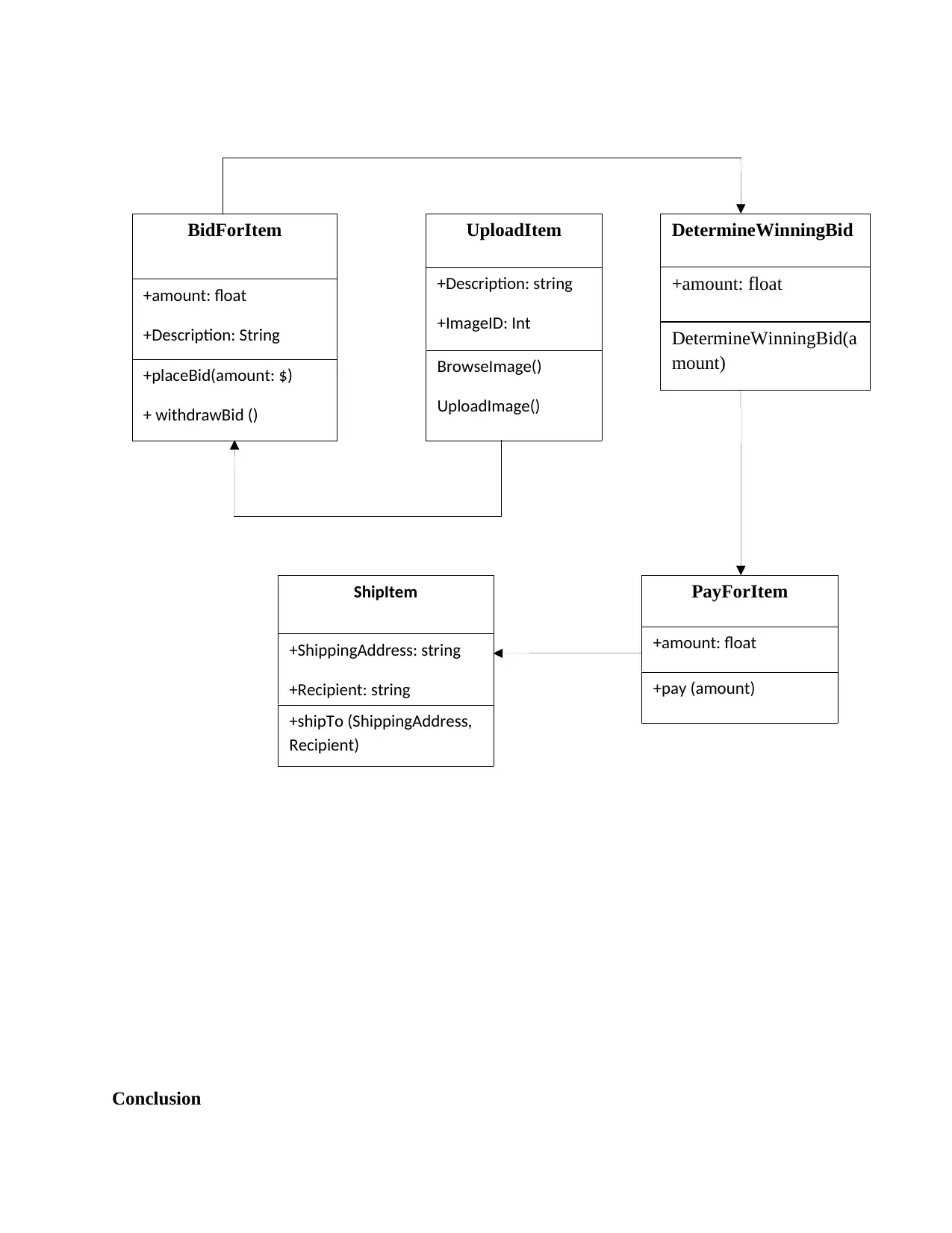
Conclusion
BidForItem
+amount: float
+Description: String
+placeBid(amount: $)
+ withdrawBid ()
UploadItem
+Description: string
+ImageID: Int
BrowseImage()
UploadImage()
DetermineWinningBid
+amount: float
DetermineWinningBid(a
mount)
PayForItem
+amount: float
+pay (amount)
ShipItem
+ShippingAddress: string
+Recipient: string
+shipTo (ShippingAddress,
Recipient)
BidForItem
+amount: float
+Description: String
+placeBid(amount: $)
+ withdrawBid ()
UploadItem
+Description: string
+ImageID: Int
BrowseImage()
UploadImage()
DetermineWinningBid
+amount: float
DetermineWinningBid(a
mount)
PayForItem
+amount: float
+pay (amount)
ShipItem
+ShippingAddress: string
+Recipient: string
+shipTo (ShippingAddress,
Recipient)
Paraphrase This Document
Need a fresh take? Get an instant paraphrase of this document with our AI Paraphraser
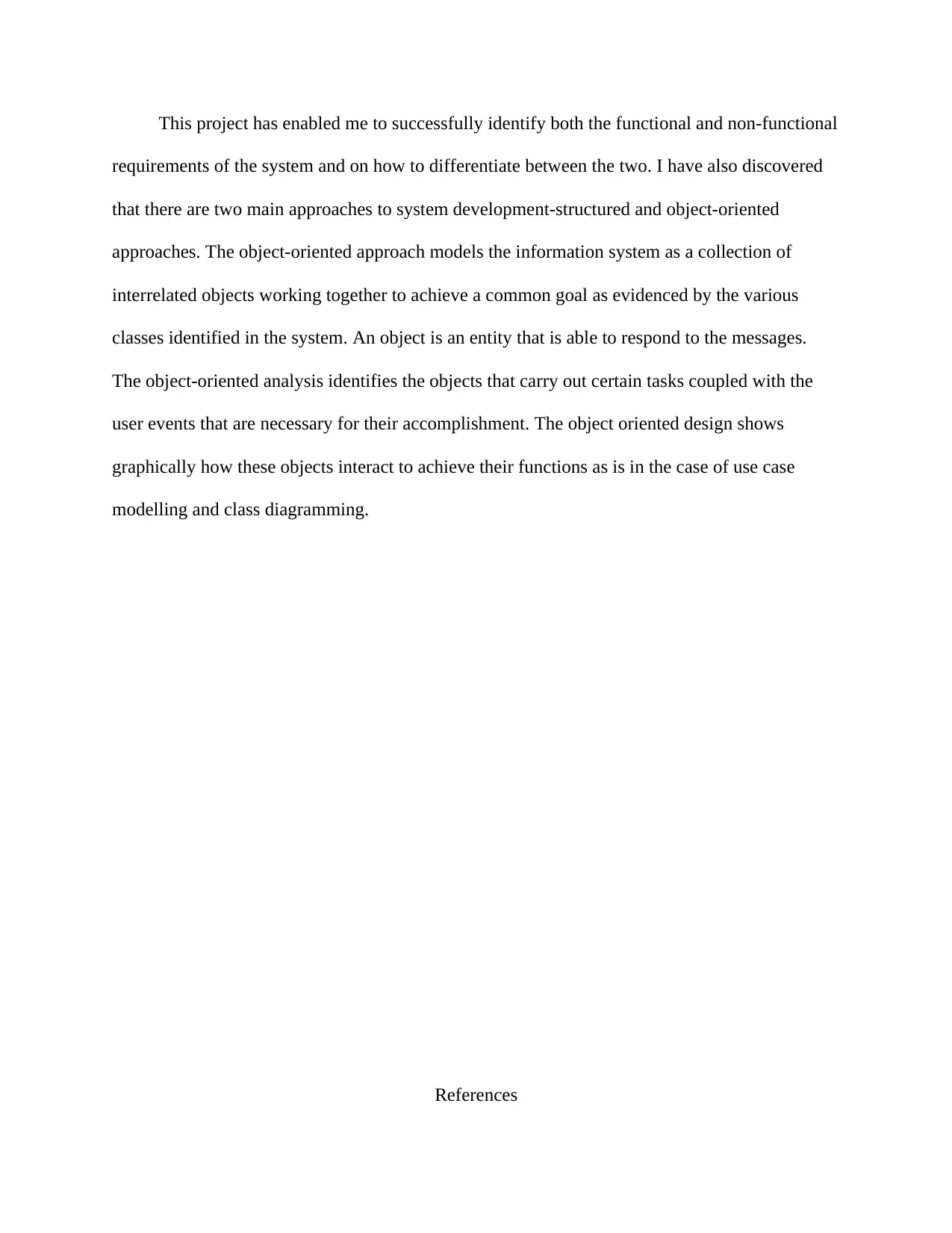
This project has enabled me to successfully identify both the functional and non-functional
requirements of the system and on how to differentiate between the two. I have also discovered
that there are two main approaches to system development-structured and object-oriented
approaches. The object-oriented approach models the information system as a collection of
interrelated objects working together to achieve a common goal as evidenced by the various
classes identified in the system. An object is an entity that is able to respond to the messages.
The object-oriented analysis identifies the objects that carry out certain tasks coupled with the
user events that are necessary for their accomplishment. The object oriented design shows
graphically how these objects interact to achieve their functions as is in the case of use case
modelling and class diagramming.
References
requirements of the system and on how to differentiate between the two. I have also discovered
that there are two main approaches to system development-structured and object-oriented
approaches. The object-oriented approach models the information system as a collection of
interrelated objects working together to achieve a common goal as evidenced by the various
classes identified in the system. An object is an entity that is able to respond to the messages.
The object-oriented analysis identifies the objects that carry out certain tasks coupled with the
user events that are necessary for their accomplishment. The object oriented design shows
graphically how these objects interact to achieve their functions as is in the case of use case
modelling and class diagramming.
References
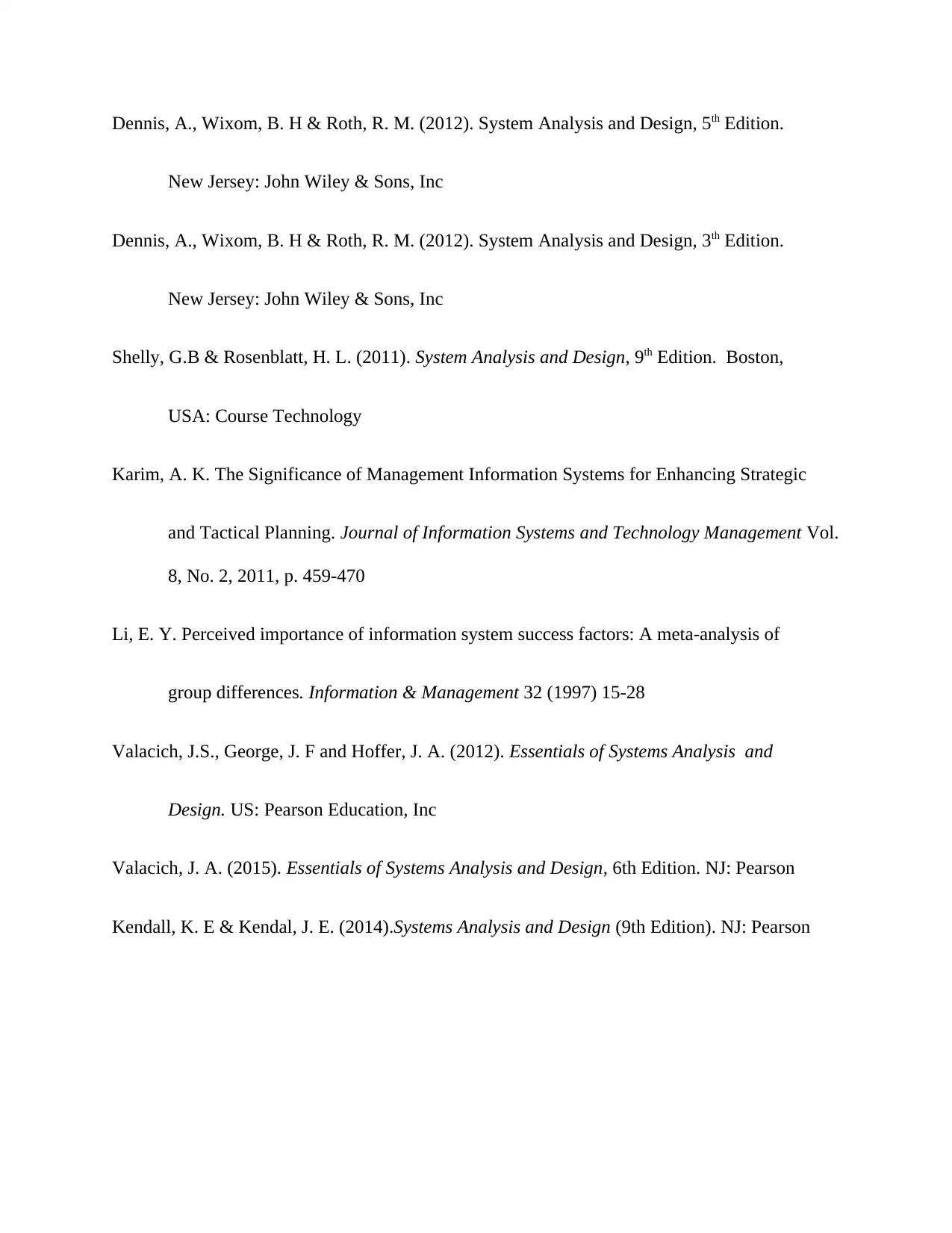
Dennis, A., Wixom, B. H & Roth, R. M. (2012). System Analysis and Design, 5th Edition.
New Jersey: John Wiley & Sons, Inc
Dennis, A., Wixom, B. H & Roth, R. M. (2012). System Analysis and Design, 3th Edition.
New Jersey: John Wiley & Sons, Inc
Shelly, G.B & Rosenblatt, H. L. (2011). System Analysis and Design, 9th Edition. Boston,
USA: Course Technology
Karim, A. K. The Significance of Management Information Systems for Enhancing Strategic
and Tactical Planning. Journal of Information Systems and Technology Management Vol.
8, No. 2, 2011, p. 459-470
Li, E. Y. Perceived importance of information system success factors: A meta-analysis of
group differences. Information & Management 32 (1997) 15-28
Valacich, J.S., George, J. F and Hoffer, J. A. (2012). Essentials of Systems Analysis and
Design. US: Pearson Education, Inc
Valacich, J. A. (2015). Essentials of Systems Analysis and Design, 6th Edition. NJ: Pearson
Kendall, K. E & Kendal, J. E. (2014).Systems Analysis and Design (9th Edition). NJ: Pearson
New Jersey: John Wiley & Sons, Inc
Dennis, A., Wixom, B. H & Roth, R. M. (2012). System Analysis and Design, 3th Edition.
New Jersey: John Wiley & Sons, Inc
Shelly, G.B & Rosenblatt, H. L. (2011). System Analysis and Design, 9th Edition. Boston,
USA: Course Technology
Karim, A. K. The Significance of Management Information Systems for Enhancing Strategic
and Tactical Planning. Journal of Information Systems and Technology Management Vol.
8, No. 2, 2011, p. 459-470
Li, E. Y. Perceived importance of information system success factors: A meta-analysis of
group differences. Information & Management 32 (1997) 15-28
Valacich, J.S., George, J. F and Hoffer, J. A. (2012). Essentials of Systems Analysis and
Design. US: Pearson Education, Inc
Valacich, J. A. (2015). Essentials of Systems Analysis and Design, 6th Edition. NJ: Pearson
Kendall, K. E & Kendal, J. E. (2014).Systems Analysis and Design (9th Edition). NJ: Pearson
⊘ This is a preview!⊘
Do you want full access?
Subscribe today to unlock all pages.

Trusted by 1+ million students worldwide
1 out of 9
Your All-in-One AI-Powered Toolkit for Academic Success.
+13062052269
info@desklib.com
Available 24*7 on WhatsApp / Email
![[object Object]](/_next/static/media/star-bottom.7253800d.svg)
Unlock your academic potential
Copyright © 2020–2025 A2Z Services. All Rights Reserved. Developed and managed by ZUCOL.